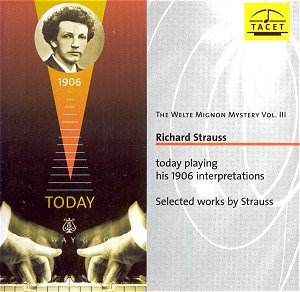This Is Not A Historical
Recording is the announcement in
the booklet of Tacet’s latest revivification
of Welte piano rolls. Their earlier
releases were of Granados and Felix
Mottl, the former playing his own works
(most important as he never left behind
disc recordings) and the latter playing
Wagner transcriptions. These restored
an important body of Welte rolls to
the contemporary catalogue.
The issue of historical
recording and piano rolls is a fraught
one, as anyone who has listened to the
numerous results can attest. A number
of companies have been active in this
market, Pierian and Naxos amongst them.
And Pierian has been exceptionally assiduous
in dealing with such as Scriabin and
Fannie Bloomfield Zeisler.
The Welte-Mignon piano
used a series of carbon rods attached
to each of the keys which lowered into
a trough of mercury to complete an electrical
circuit when the pianist hit a note.
The circuit caused inked rollers to
mark a roll of paper with the note itself
and also the speed and depth of the
attacked note. Playback was possible
before the roll was manually perforated
for public consumption on a player-piano.
Theoretically then dynamic shading and
pedalling could be registered by the
complex system but Welte-Mignon was,
irrespective of the secrecies and ambiguities
of the system, something of a world
leader in the player-piano world. Something
of their eminence can be gauged by the
composers who went to record for them
- Mahler, Ravel and Debussy amongst
them.
And, here is Strauss,
recorded in February 1906. The selection
is somewhat odd to put it mildly. There
are fragments of Salome, including the
Dance of the Seven Veils, a sliver from
Ein Heldenleben and most congruously,
four of the five Stimmungsbilder Op.9
with a double envoi of Cäcilie
and – to give it its English translation
- Secret Invitation. The Salome fragments
show one of the besetting faults of
the roll system, its inherently lumpy
rhythm. It’s difficult to believe that
Strauss could have played with such
lumpen and effortful pianism – we know
his stature as a pianist not least from
a number of live broadcast performances
of his songs that have been preserved.
The Dance of the Seven
Veils is somewhat better in this respect
but the excerpt from Feuersnot is as
unconvincing an index of Strauss the
pianist as is the Salome fragment. Best
of all are a couple of the Stimmungsbilder
– Nos. 1 and 3 in particular – Am
stillen Waldespfad and the Intermezzo.
Here we can feel something at least
of Strauss’ eloquence, even if the results
must be considered provisional. Tacet’s
reproducing piano sounds to be in tune
and without any off-puttingly noisy
action problems – and this is by no
means usual amongst roll discs of this
kind.
Jonathan Woolf


